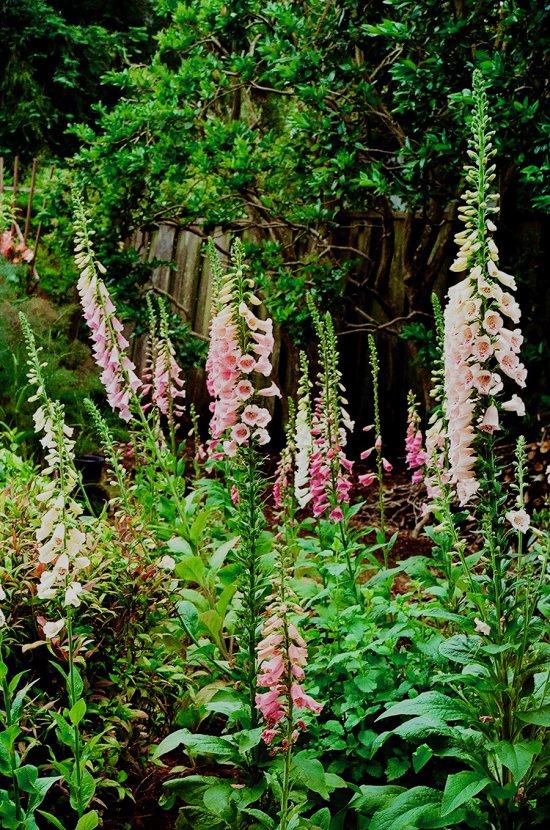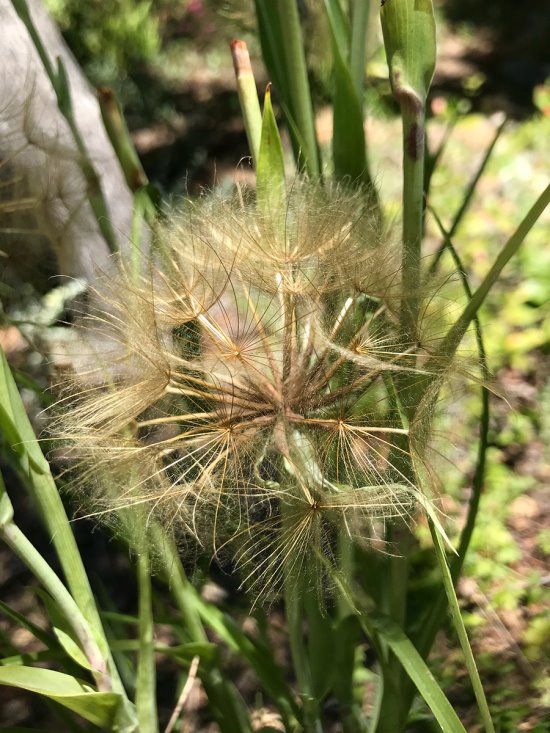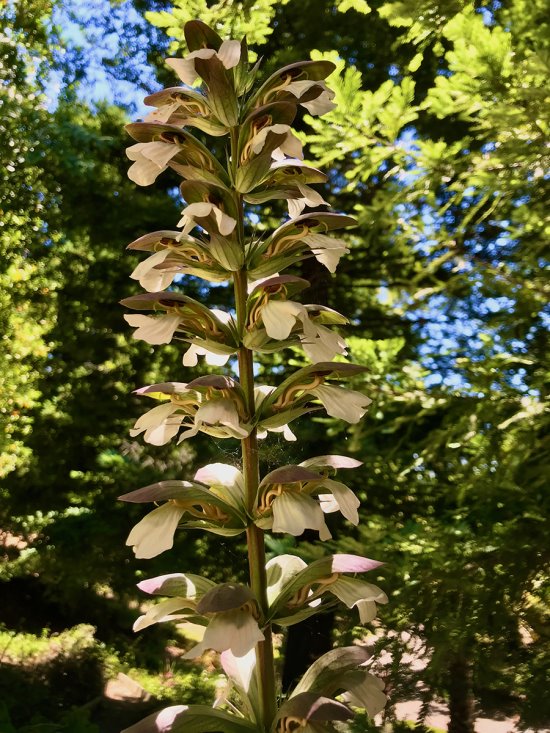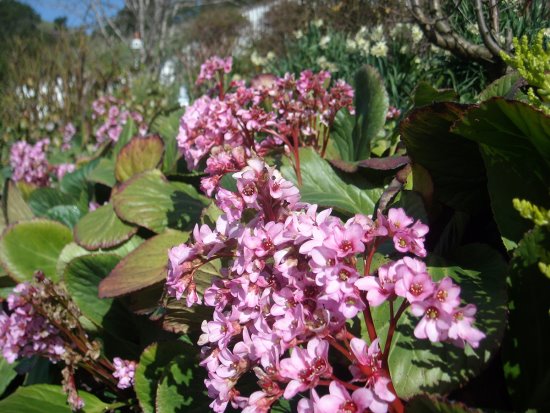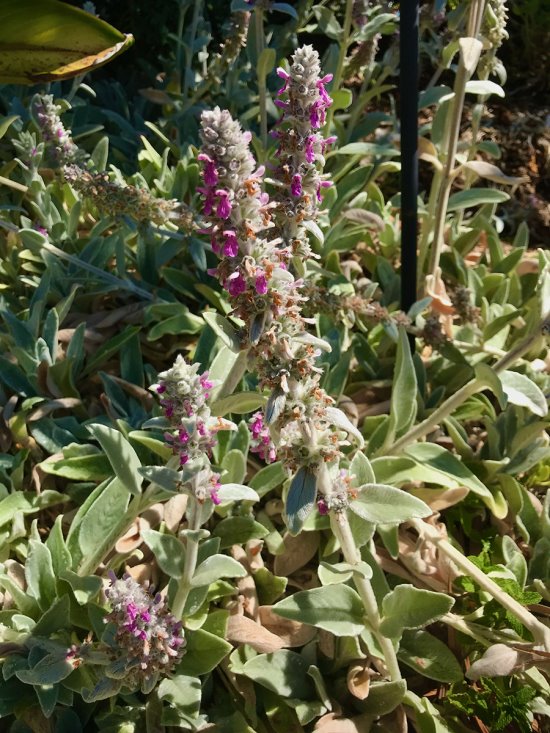 | | | Lambsear is soft and fuzzy just like a baby lamb. Photo Cynthia Brian | | | | | | "We can judge the heart of a man by his treatment of animals." ~ Immanual Kant
 Our family has enjoyed an affinity for the animal kingdom for as long as I can remember. We loved creatures so much that we often named a pet for an animal of another species that they resembled. We've had dogs named Bear and Wolf, cats named Panther and Tiger, and even a horse named Spider, although he didn't look like an arachnid.
Our family has enjoyed an affinity for the animal kingdom for as long as I can remember. We loved creatures so much that we often named a pet for an animal of another species that they resembled. We've had dogs named Bear and Wolf, cats named Panther and Tiger, and even a horse named Spider, although he didn't look like an arachnid.
 In the plant world, botanists and taxonomists who name plants also look to the realm of animals using zoographical Latin or Greek-based names for various genera and species. Sometimes a part of the plant will remind them of an animal, or sometimes it is the marketing department of a plant breeder that comes up with the fun, and often humorous name for a new cultivar.
In the plant world, botanists and taxonomists who name plants also look to the realm of animals using zoographical Latin or Greek-based names for various genera and species. Sometimes a part of the plant will remind them of an animal, or sometimes it is the marketing department of a plant breeder that comes up with the fun, and often humorous name for a new cultivar.
 I walked through my garden giggling at the numerous "animals" that are growing. Trees, flowers, wildflowers, and even weeds bear the names of creatures. If you are looking for an amusing gardening endeavor to do with children this fall, ask them if they would like to plant an animal garden. Discuss their favorite critters, then research specimens to fit the bill.
I walked through my garden giggling at the numerous "animals" that are growing. Trees, flowers, wildflowers, and even weeds bear the names of creatures. If you are looking for an amusing gardening endeavor to do with children this fall, ask them if they would like to plant an animal garden. Discuss their favorite critters, then research specimens to fit the bill.
 Edit your list grouping plants that will demand the same soil, watering, and sun/shade conditions together in one plot or pot. Mix annuals and perennials for an ongoing animal parade that will last throughout the year. Engage in a creative craft project making nametags for each plant. (Popsicle sticks are traditional favorites) Because the weather is too hot and dry to plant in summer, it's advised to wait for the cooler days of autumn to start digging a new garden. However, if you want to plant a few species in containers now, let the animal party begin. Make sure to follow directions on the plant tags and water frequently as containers lose moisture quickly.
Edit your list grouping plants that will demand the same soil, watering, and sun/shade conditions together in one plot or pot. Mix annuals and perennials for an ongoing animal parade that will last throughout the year. Engage in a creative craft project making nametags for each plant. (Popsicle sticks are traditional favorites) Because the weather is too hot and dry to plant in summer, it's advised to wait for the cooler days of autumn to start digging a new garden. However, if you want to plant a few species in containers now, let the animal party begin. Make sure to follow directions on the plant tags and water frequently as containers lose moisture quickly.
 Here is a partial list of the excitement to come with animal plants:
Here is a partial list of the excitement to come with animal plants:
 Lambsquarter
Lambsquarter
 Cats Ear
Cats Ear
 Chickweed
Chickweed
 Coyote Bush
Coyote Bush
 Buzzard Breath
Buzzard Breath
 Duck Salad
Duck Salad
 Cockle Bur
Cockle Bur
 Fleabane
Fleabane
 Henbit
Henbit
 Goosefoot
Goosefoot
 Turkey Mullein
Turkey Mullein
 Horseweed
Horseweed
 Pigweed
Pigweed
 Prickly Oxtongue
Prickly Oxtongue
 Goose Grass
Goose Grass
 Foxtails
Foxtails
 Cattails
Cattails
 Swinecress
Swinecress
 Birdseye Pearlwort
Birdseye Pearlwort
 Goosefoot
Goosefoot
 Fat hen
Fat hen
 Dogwood
Dogwood
 Elephant Ears
Elephant Ears
 Catnip
Catnip
 Deerweed
Deerweed
 Wolfsbane
Wolfsbane
 Dogbane
Dogbane
 Foxglove
Foxglove
 Henbane
Henbane
 Horse Chestnut
Horse Chestnut
 Leopard's Bane
Leopard's Bane
 Bee Balm
Bee Balm
 Monkey Grass
Monkey Grass
 Donkey Tail
Donkey Tail
 Butterfly Bush
Butterfly Bush
 Locust Tree
Locust Tree
 Cockscomb
Cockscomb
 Gopher Plant
Gopher Plant
 Hen and Chicks
Hen and Chicks
 Pussywillow
Pussywillow
 Skunk Plant
Skunk Plant
 Snake plant
Snake plant
 Starfish Flower
Starfish Flower
 Zebra plant
Zebra plant
 Lambs Ears
Lambs Ears
 Bear's Breeches
Bear's Breeches
 Trout Lily
Trout Lily
 Pigsqueak (Bergenia)
Pigsqueak (Bergenia)
 Cardinal Flower
Cardinal Flower
 Deer fern
Deer fern
 Deer tongue
Deer tongue
 Dragon lily
Dragon lily
 Snapdragon
Snapdragon
 Catchfly
Catchfly
 Foxtrot
Foxtrot
 Horsetail
Horsetail
 Lion's Tail
Lion's Tail
 Lobster Claws
Lobster Claws
 Mouse plant
Mouse plant
 Ox-eye daisy
Ox-eye daisy
 Panda wild ginger
Panda wild ginger
 Pig butt
Pig butt
 Rabbit's foot fern
Rabbit's foot fern
 Porcupine Agave
Porcupine Agave
 Tickseed
Tickseed
 Toad lily
Toad lily
 Wormwood
Wormwood
 Cranesbill geranium
Cranesbill geranium
 Lion's Ear
Lion's Ear
 Turtlehead
Turtlehead
 Spider plant
Spider plant
 Crabgrass
Crabgrass
 Scorpions tail
Scorpions tail
 Flamingo flower
Flamingo flower
 Kangaroo paw
Kangaroo paw
 Bunny Tails
Bunny Tails
 Butterfly weed
Butterfly weed
 Partridge Berry
Partridge Berry
 Fishtail palm
Fishtail palm
 Leopard's bane
Leopard's bane
 Zebra grass
Zebra grass
 Spiderwort
Spiderwort
 Squirrel cup
Squirrel cup
 Wake robin
Wake robin
 Dinosaur tree
Dinosaur tree
 Hedgehog echinacea
Hedgehog echinacea
 Treat your animal plants with care.
Treat your animal plants with care.
 Amuse yourself, your family, and your friends with your garden barnyard!
Amuse yourself, your family, and your friends with your garden barnyard!
 Happy Gardening and Happy Growing!
Happy Gardening and Happy Growing!
 Cynthia Brian's Mid-Month Gardening Tips
Cynthia Brian's Mid-Month Gardening Tips
 - SPREAD a blanket on the lawn and look toward the heavens to see animal shapes in the clouds.
- SPREAD a blanket on the lawn and look toward the heavens to see animal shapes in the clouds.
 - DRY herbs by hanging bunches upside down in a dry place, like a garage or shed. Dry lavender, sage, thyme, rosemary, and oregano. Store the dried leaves in a jar.
- DRY herbs by hanging bunches upside down in a dry place, like a garage or shed. Dry lavender, sage, thyme, rosemary, and oregano. Store the dried leaves in a jar.
 - DOUSE weeds with a concoction of white vinegar and liquid dish soap. To a gallon of the vinegar, add a capful of dish soap, shake in a spray bottle, and use proactively.
- DOUSE weeds with a concoction of white vinegar and liquid dish soap. To a gallon of the vinegar, add a capful of dish soap, shake in a spray bottle, and use proactively.
 - GATHER the seeds of fennel and cilantro after the flowers are spent. Dry the seeds on a cooking sheet. Cilantro seeds are called coriander. Both add flavor and texture to both sweet and savory recipes.
- GATHER the seeds of fennel and cilantro after the flowers are spent. Dry the seeds on a cooking sheet. Cilantro seeds are called coriander. Both add flavor and texture to both sweet and savory recipes.
 - PRESERVE flat-leaf parsley, basil, and chives by freezing them in ice cube trays. Put a spoonful of the chopped leaves in each cell, add water, and freeze. When you want a dash of fresh flavor, pop an ice cube.
- PRESERVE flat-leaf parsley, basil, and chives by freezing them in ice cube trays. Put a spoonful of the chopped leaves in each cell, add water, and freeze. When you want a dash of fresh flavor, pop an ice cube.
 - PLANT edamame and sweet potatoes, both warm-weather crops. The soil needs to be warmer than 60 degrees. Plan on harvesting edamame in 90-100 days when the pods are plump but still green for a heart healthy omega 3 boost. To make potassium-rich sweet potatoes sweeter, store at 90 degrees for two weeks after harvesting.
- PLANT edamame and sweet potatoes, both warm-weather crops. The soil needs to be warmer than 60 degrees. Plan on harvesting edamame in 90-100 days when the pods are plump but still green for a heart healthy omega 3 boost. To make potassium-rich sweet potatoes sweeter, store at 90 degrees for two weeks after harvesting.
 - DEADHEAD roses, annuals, and perennials as blooms fade to keep them coming through frost.
- DEADHEAD roses, annuals, and perennials as blooms fade to keep them coming through frost.
 - GROW celery by rooting the base of your store-bought vegetable. Put the stub in a glass jar filled with water in a sunny location, then transplant the root to a container or garden.
- GROW celery by rooting the base of your store-bought vegetable. Put the stub in a glass jar filled with water in a sunny location, then transplant the root to a container or garden.
 - HARVEST cucumbers and make an easy spicy summer snack as well as a soothing eye pack. Peel, slice, add red onions, rice vinegar, and marinate for one hour in the refrigerator. Save the peels to place on your eyes to eliminate puffiness after swimming.
- HARVEST cucumbers and make an easy spicy summer snack as well as a soothing eye pack. Peel, slice, add red onions, rice vinegar, and marinate for one hour in the refrigerator. Save the peels to place on your eyes to eliminate puffiness after swimming.
 - WATCH butterflies pollinate your flowers as they flutter from blossom to blossom on monarda, tithonia, sunflowers, zinnias, butterfly bush, cosmos, alyssum, marigolds, thyme, oregano, and marjoram.
- WATCH butterflies pollinate your flowers as they flutter from blossom to blossom on monarda, tithonia, sunflowers, zinnias, butterfly bush, cosmos, alyssum, marigolds, thyme, oregano, and marjoram.
 - EXTEND your garden's production with a second season planting of beets, scallions, kohlrabi, chard, broccoli, lettuce, peas, and carrots to carry your fresh offerings into late fall.
- EXTEND your garden's production with a second season planting of beets, scallions, kohlrabi, chard, broccoli, lettuce, peas, and carrots to carry your fresh offerings into late fall.
 - TOSS a salad comprised of edible herbs, tender leaves, and fruit from your garden including basil, sage, thyme, lovage, fennel, arugula, spinach, chives, chard, tarragon, kale, beet tops, lettuce, cilantro, parsley, sorrel, apples, and plums dressed with lemon juice and olive oil for a tasty jolt of mineral rich nutrition.
- TOSS a salad comprised of edible herbs, tender leaves, and fruit from your garden including basil, sage, thyme, lovage, fennel, arugula, spinach, chives, chard, tarragon, kale, beet tops, lettuce, cilantro, parsley, sorrel, apples, and plums dressed with lemon juice and olive oil for a tasty jolt of mineral rich nutrition.
 - SHARE your excess vegetable and fruit harvest with the neighborhood and take the extras to the local food bank for those in need to savor.
- SHARE your excess vegetable and fruit harvest with the neighborhood and take the extras to the local food bank for those in need to savor. |

